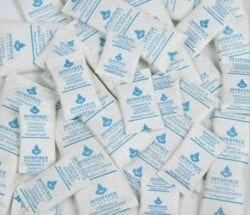Desiccant packs, those small sachets often found nestled in product packaging, play a crucial role in maintaining the integrity of various goods. Despite their unassuming appearance, these tiny packets contain powerful moisture-absorbing agents that safeguard products from moisture-related damage. In this comprehensive guide, we delve into the intricacies of desiccant packets, exploring their functions, types, applications, and disposal methods.
Understanding Desiccant Packs
Desiccant packs are primarily designed to control moisture levels in enclosed spaces. Their fundamental purpose is to absorb excess moisture, preventing the onset of mold, mildew, corrosion, and other forms of deterioration that can compromise product quality. These packs typically consist of a porous material—such as silica gel, activated charcoal, clay, or molecular sieves—encased in a permeable pouch.
Types of Desiccants
- Silica Gel: Among the most common desiccants, silica gel effectively absorbs moisture and maintains relative humidity levels in a variety of products, including electronics, pharmaceuticals, and food items.
- Clay: Clay desiccants, composed of natural clay minerals, provide reliable moisture absorption for sensitive products like leather goods and textiles.
- Molecular Sieves: These highly absorbent materials excel in applications requiring extremely low levels of moisture, such as in the production of plastics and chemicals.
- Activated Charcoal: Known for its odor-absorbing properties, activated charcoal desiccants are often used in packaging for shoes, clothing, and electronics to prevent musty odors.
Applications of Desiccant Packs
Desiccant packs find widespread use across various industries and applications, including:
- Pharmaceuticals: Desiccants preserve the efficacy and shelf life of medications by preventing moisture-induced degradation.
- Electronics: Moisture-sensitive electronic components are protected from corrosion and malfunction during storage and transportation.
- Food Packaging: Desiccants prevent moisture-related spoilage in packaged foods, extending their shelf life and preserving quality.
- Textiles and Apparel: Clothing and textiles are shielded from mold and mildew, ensuring they remain fresh and pristine until use.
- Storage and Transportation: Desiccant packs are indispensable for safeguarding goods during long-distance shipping and storage in humid environments.
Selecting the Right Desiccant
Choosing the appropriate desiccant depends on factors such as:
- Moisture Sensitivity: Assess the level of moisture sensitivity of the product to determine the optimal desiccant type and quantity.
- Packaging Space: Consider the available space within the packaging and select desiccant packs that fit comfortably without obstructing other components.
- Environmental Conditions: Evaluate the anticipated storage or transportation environment, including temperature and humidity levels, to select desiccants capable of providing adequate protection.
Handling and Disposal
While desiccant packs are generally safe to handle, it\'s essential to follow proper precautions to minimize any potential risks. Avoid direct contact with eyes or ingestion of desiccant contents, and keep them out of reach of children and pets. When disposing of used desiccant packs, follow local regulations regarding waste disposal. Many desiccants can be safely disposed of in household trash, while others may require special handling due to their chemical composition.
Conclusion
Desiccant packs may be small in size, but their impact on product quality and longevity is significant. By effectively controlling moisture levels, these humble sachets play a vital role in preserving a wide range of goods, from electronics to pharmaceuticals. Understanding the different types of desiccants, their applications, and proper handling and disposal methods is essential for ensuring optimal product protection and safety. Whether safeguarding electronics during transit or preserving the freshness of packaged foods, desiccant packs are indispensable allies in the battle against moisture-related damage.


